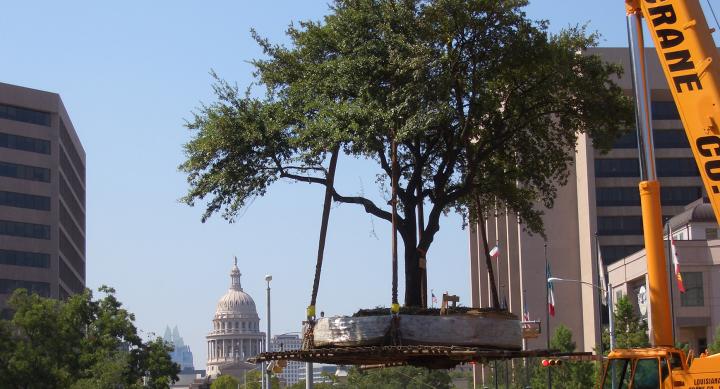
Relocating a mature live oak to make way for the Dell Medical School complex
The Campus Sustainability Policy, adopted in April 2008, requires that policies, practices and curricula at The University of Texas at Austin strive to reduce life cycle costs, restore or maintain functioning natural systems, and enhance human well-being.
UT Austin—one of the first public institutions of higher education in Texas to rigorously focus on sustainability—continues to lead among universities by reducing waste, conserving energy and water resources, constructing green buildings and landscapes, and much more. But the tradition of sustainability also runs deep:
- 1930s Prompted by faculty, the Hal C. Weaver power plant is converted from coal to natural gas. Since then, the main campus has produced all of its own electrical power and the heating and cooling for all buildings.
- 1970s The first Earth Day was celebrated in April 1970. SCOPE, the Student Committee on Pollution of the Environment, was formed, and professors held a series of teach-ins on environmental topics like population growth.
- 1980s The University of Texas at Austin bus system—one of the largest university transit systems in the country—is established.
- 2002 The student-led Campus Environmental Center is established with the mission “to empower the UT community to reduce its negative environmental impact and to foster a genuine culture of sustainability on campus through collaborative and constructive means.”
- 2007 The Departments for Housing and Food Service provide ENERGY STAR refrigerators, freezers, and microwaves in all residence halls, and first LEED-certified building added to the University of Texas system (the ROC building on the J.J. Pickle Research Campus).
- 2009 Office of Sustainability is established.
- 2010 Students pass a referendum with 71% support establishing a Green Fee (now Green Fund) that typically generates $500,000 a year in funds for ‘environmental service’ projects on campus and the campus hold first Sustainability Symposium.
- 2011 The Concho Community Garden, which later becomes the MicroFarm, is established in East Campus with funding from the Green Fee (now Green Fund).
- 2012 The Orange Bike Project, a student organization that rents bikes to students and was formed within the Campus Environmental Center in 2009, is officially sponsored by Parking & Transportation Services.
- 2014 The Lady Bird Johnson Wildflower Center partnered with the United States Botanic Garden and the American Society of Landscape Architects to establish the SITES Rating System for sustainable landscape design.
- 2015 The Utilities and Energy Management receives PEER Certification by the Green Business Certification Inc (GBCI) as an example of sustainable electricity system design.
- 2016 Sustainability Master Plan adopted.
- 2020 UT Austin achieves a Gold rating from the Sustainability Tracking Assessment & Rating System (STARS).
